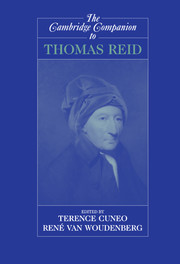Book contents
- Frontmatter
- Introduction
- 1 Reid in Context
- 2 Thomas Reid and the Culture of Science
- 3 Reid on Common Sense
- 4 Reid’s Theory of Perception
- 5 Reid’s Reply to the Skeptic
- 6 Nativism and the Nature of Thought in Reid’s Account of Our Knowledge of the External World
- 7 Reid and the Social Operations of Mind
- 8 Reid on Memory and the Identity of Persons
- 9 Thomas Reid’s Theory of Freedom and Responsibility
- 10 Reid’s Moral Philosophy
- 11 Reid’s Philosophy of Art
- 12 Reid’s Philosophy of Religion
- 13 Reid’s Influence in Britain, Germany, France, and America
- Bibliography
- Index
4 - Reid’s Theory of Perception
Published online by Cambridge University Press: 28 May 2006
- Frontmatter
- Introduction
- 1 Reid in Context
- 2 Thomas Reid and the Culture of Science
- 3 Reid on Common Sense
- 4 Reid’s Theory of Perception
- 5 Reid’s Reply to the Skeptic
- 6 Nativism and the Nature of Thought in Reid’s Account of Our Knowledge of the External World
- 7 Reid and the Social Operations of Mind
- 8 Reid on Memory and the Identity of Persons
- 9 Thomas Reid’s Theory of Freedom and Responsibility
- 10 Reid’s Moral Philosophy
- 11 Reid’s Philosophy of Art
- 12 Reid’s Philosophy of Religion
- 13 Reid’s Influence in Britain, Germany, France, and America
- Bibliography
- Index
Summary
Perception bulks large in Reid's published writings. Nearly all of the Inquiry into the Human Mind is devoted to it, with chapters allotted to each of the senses of Smelling, Hearing, Tasting, Touch, and Seeing. And in the Essays on the Intellectual Powers of Man, by far the longest essay is Essay II, “Of the Powers we Have by Means of our External Senses” The main theme of this chapter is Reid's attack on the reigning “way of ideas” and his attempt to put in its place a direct realist theory of perception. Also covered are Reid's distinction between sensation and perception, his views on primary and secondary qualities, his nativism about our conceptions of hardness and extension, and his treatment of the phenomenon of acquired perception.
I. CRITIQUE OF THE THEORY OF IDEAS
Almost alone among the great modern philosophers, Reid sought to uphold a direct realist theory of perception. He repudiated the theory of ideas, the central tenet of which is that the object immediately present to the mind is never an external thing, but only an internal image, sense datum, representation, or (to use the most common eighteenth-century term) idea. Ideas were conceived of as mental entities that existed only as long as there was awareness of them. Some proponents of the theory of ideas (such as Descartes and Locke) were realists, conceiving of physical objects as things distinct from ideas that cause ideas of them to arise in our minds.
- Type
- Chapter
- Information
- The Cambridge Companion to Thomas Reid , pp. 101 - 133Publisher: Cambridge University PressPrint publication year: 2004
- 20
- Cited by



